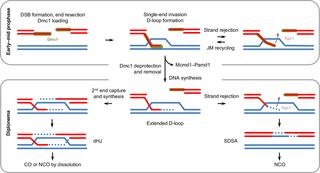当前位置:
X-MOL 学术
›
PLOS Genet.
›
论文详情
Our official English website, www.x-mol.net, welcomes your feedback! (Note: you will need to create a separate account there.)
An MCM family protein promotes interhomolog recombination by preventing precocious intersister repair of meiotic DSBs.
PLOS Genetics ( IF 4.5 ) Pub Date : 2019-12-09 , DOI: 10.1371/journal.pgen.1008514 Miao Tian 1 , Josef Loidl 1
PLOS Genetics ( IF 4.5 ) Pub Date : 2019-12-09 , DOI: 10.1371/journal.pgen.1008514 Miao Tian 1 , Josef Loidl 1
Affiliation

|
Recombinational repair of meiotic DNA double-strand breaks (DSBs) uses the homologous chromosome as a template, although the sister chromatid offers itself as a spatially more convenient substrate. In many organisms, this choice is reinforced by the recombination protein Dmc1. In Tetrahymena, the repair of DSBs, which are formed early in prophase, is postponed to late prophase when homologous chromosomes and sister chromatids become juxtaposed owing to tight parallel packing in the thread-shaped nucleus, and thus become equally suitable for use as repair templates. The delay in DSB repair is achieved by rejection of the invading strand by the Sgs1 helicase in early meiotic prophase. In the absence of Mcmd1, a meiosis-specific minichromosome maintenance (MCM)-like protein (and its partner Pamd1), Dmc1 is prematurely lost from chromatin and DNA synthesis (as monitored by BrdU incorporation) takes place in early prophase. In mcmd1Δ and pamd1Δ mutants, only a few crossovers are formed. In a mcmd1Δ hop2Δ double mutant, normal timing of Dmc1 loss and DNA synthesis is restored. Because Tetrahymena Hop2 is believed to enable homologous strand invasion, we conclude that Dmc1 loss in the absence of Mcmd1 affects only post-invasion recombination intermediates. Therefore, we propose that the Dmc1 nucleofilament becomes dismantled immediately after forming a heteroduplex with a template strand. As a consequence, repair synthesis and D-loop extension starts in early prophase intermediates and prevents strand rejection before the completion of homologous pairing. In this case, DSB repair may primarily use the sister chromatid. We conclude that Mcmd1‒Pamd1 protects the Dmc1 nucleofilament from premature dismantling, thereby suppressing precocious repair synthesis and excessive intersister strand exchange at the cost of homologous recombination.
中文翻译:

MCM 家族蛋白通过防止减数分裂 DSB 的早熟姐妹间修复来促进同源基因间重组。
减数分裂 DNA 双链断裂 (DSB) 的重组修复使用同源染色体作为模板,尽管姐妹染色单体提供自己作为空间上更方便的底物。在许多生物体中,重组蛋白 Dmc1 加强了这种选择。在四膜虫中,在前期早期形成的 DSBs 的修复被推迟到晚期前期,当同源染色体和姐妹染色单体由于线状细胞核中紧密平行堆积而并列时,因此变得同样适合用作修复模板. DSB 修复的延迟是通过在减数分裂早期早期 Sgs1 解旋酶拒绝入侵链来实现的。在没有 Mcmd1 的情况下,一种减数分裂特异性微染色体维持 (MCM) 样蛋白(及其伴侣 Pamd1),Dmc1 从染色质中过早丢失,DNA 合成(由 BrdU 掺入监测)发生在早期前期。在 mcmd1Δ 和 pamd1Δ 突变体中,仅形成少数交叉。在 mcmd1Δ hop2Δ 双突变体中,恢复了 Dmc1 丢失和 DNA 合成的正常时间。因为四膜虫 Hop2 被认为能够实现同源链入侵,我们得出结论,在没有 Mcmd1 的情况下 Dmc1 损失仅影响入侵后重组中间体。因此,我们建议 Dmc1 核丝在与模板链形成异源双链后立即被拆除。因此,修复合成和 D 环延伸开始于早期的前期中间体,并在同源配对完成之前防止链排斥。在这种情况下,DSB 修复可能主要使用姐妹染色单体。
更新日期:2019-12-11
中文翻译:

MCM 家族蛋白通过防止减数分裂 DSB 的早熟姐妹间修复来促进同源基因间重组。
减数分裂 DNA 双链断裂 (DSB) 的重组修复使用同源染色体作为模板,尽管姐妹染色单体提供自己作为空间上更方便的底物。在许多生物体中,重组蛋白 Dmc1 加强了这种选择。在四膜虫中,在前期早期形成的 DSBs 的修复被推迟到晚期前期,当同源染色体和姐妹染色单体由于线状细胞核中紧密平行堆积而并列时,因此变得同样适合用作修复模板. DSB 修复的延迟是通过在减数分裂早期早期 Sgs1 解旋酶拒绝入侵链来实现的。在没有 Mcmd1 的情况下,一种减数分裂特异性微染色体维持 (MCM) 样蛋白(及其伴侣 Pamd1),Dmc1 从染色质中过早丢失,DNA 合成(由 BrdU 掺入监测)发生在早期前期。在 mcmd1Δ 和 pamd1Δ 突变体中,仅形成少数交叉。在 mcmd1Δ hop2Δ 双突变体中,恢复了 Dmc1 丢失和 DNA 合成的正常时间。因为四膜虫 Hop2 被认为能够实现同源链入侵,我们得出结论,在没有 Mcmd1 的情况下 Dmc1 损失仅影响入侵后重组中间体。因此,我们建议 Dmc1 核丝在与模板链形成异源双链后立即被拆除。因此,修复合成和 D 环延伸开始于早期的前期中间体,并在同源配对完成之前防止链排斥。在这种情况下,DSB 修复可能主要使用姐妹染色单体。



























 京公网安备 11010802027423号
京公网安备 11010802027423号